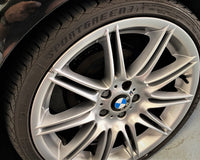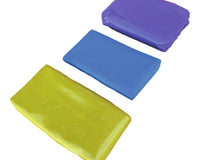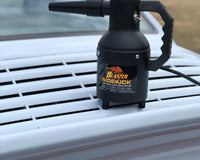Clay bars have become a cornerstone of professional and DIY car detailing due to their ability to remove contaminants that traditional washing and polishing can’t tackle. When applied correctly, clay bars smooth the vehicle's surface, enhancing the paint's clarity, shine, and overall condition. This guide explores why clay bars are essential in car detailing and provides a step-by-step guide on using them safely and effectively.
Why Clay Bars Are Essential in Car Detailing
Clay bars are indispensable in car detailing because they offer a thorough level of decontamination, unlike standard car washing methods. Car surfaces are constantly exposed to airborne contaminants such as dust, tree sap, industrial fallout, brake dust, and more. These particles cling to the paint and can slowly erode it over time if not removed.
Removing Deep-Seated Contaminants
Standard washing removes surface dirt but often leaves behind embedded contaminants that cling stubbornly to the paint. Clay bars are designed to grab and lift these impurities, creating a cleaner and smoother surface. This step is particularly useful before waxing or applying sealant, as it ensures these products adhere better, offering longer-lasting protection.
Smoother, Glossier Paint Finish
Contaminants create a rough texture on the paint's surface that not only looks unappealing but can also make waxing and polishing less effective. After claying, the surface feels smooth to the touch, allowing for a more even application of protective coatings and enhancing the depth and shine of your paint.
Prolonged Paint Life and Increased Durability
Regular use of a clay bar helps remove contaminants before they have a chance to penetrate the clear coat, prolonging the life of your vehicle’s paint. By keeping contaminants at bay, you’re essentially preventing micro-scratches and paint degradation, ensuring that your car’s finish remains pristine for a longer period.
When to Use a Clay Bar
Knowing when to use a clay bar can make a significant difference in maintaining your car’s finish. While it’s not necessary every time you wash your car, it’s recommended to incorporate claying into your routine a few times a year.
Testing the Surface for Roughness
A simple way to test whether your car needs claying is by running your fingers over the surface after a wash. If you feel any rough or gritty patches, these are likely contaminants embedded in the paint. You can also place a thin plastic bag over your hand and run it over the paint to detect rough spots more easily.
Before Polishing or Waxing
Claying is an essential step before polishing or waxing, as it clears away embedded particles that could interfere with the application of these products. A smooth, clean surface ensures that wax, polish, or sealants adhere more effectively, resulting in a longer-lasting, glossier finish.
After Environmental Exposure
If your car has been exposed to harsh conditions—such as tree sap, industrial areas, or high pollution zones—it’s wise to use a clay bar. These conditions often lead to the build-up of contaminants that regular washing can’t fully remove.
How to Choose the Right Clay Bar
Clay bars come in various grades and types, with different levels of aggressiveness. Choosing the right one depends on the condition of your car’s paint and how contaminated the surface is.
Fine Grade for Light Contamination
For newer cars or those with relatively mild contamination, a fine-grade clay bar is typically sufficient. These are gentle on the paint and work well for regular maintenance without causing micro-scratches.

Medium and Heavy Grades for Older or Heavily Contaminated Surfaces
If your car has heavy contamination or hasn’t been clayed in a long time, a medium or heavy-grade clay bar may be necessary. However, be cautious when using a heavy-grade clay bar, as it has a higher abrasive level, which can cause slight marring on delicate paint. Polishing afterward is often recommended to restore a smooth, even surface.
Synthetic Clay Alternatives
In recent years, synthetic clay mitts and cloths have become popular alternatives. These products are easier to handle, quicker to use, and last longer than traditional clay bars. They perform similarly to clay bars and are a great option for those looking to simplify the process.
Step-by-Step Guide to Using a Clay Bar
Using a clay bar correctly is essential for achieving a smooth, contaminant-free finish without damaging the paint. Here’s a detailed, step-by-step guide to help you get the best results.
Step 1: Thoroughly Wash the Car
Start by washing your car thoroughly to remove surface dirt and grime. This step prevents the clay from dragging large particles across the paint, which could cause scratches. Use a pH-balanced car shampoo and rinse the vehicle completely.
Step 2: Choose a Quality Clay Lubricant
Clay bars require a lubricant to glide smoothly over the paint without sticking or causing damage. A dedicated clay lubricant is ideal, but you can also use a quick detailer or a diluted car shampoo solution. Avoid using just water, as it doesn’t provide adequate lubrication and can cause the clay to stick.
Step 3: Mould and Flatten the Clay Bar
Break off a small piece of the clay bar and knead it until it becomes pliable. Then flatten it into a disc shape, which increases the surface area and makes it easier to handle. This ensures that it covers more of the paint in each pass.
Step 4: Work in Small Sections
Spray a liberal amount of clay lubricant onto a small section of the car, about 30cm x 30cm. Gently rub the clay back and forth in a straight line, applying only light pressure. Avoid circular motions to prevent any unnecessary friction. As the clay glides over the paint, you’ll feel it pulling contaminants out of the surface.
Step 5: Check and Re-Knead the Clay
After working on a section, inspect the clay for contaminants. If it appears dirty, fold and knead it to reveal a clean surface before moving to the next section. Discard the clay bar if it becomes too contaminated, as using a dirty clay bar can scratch the paint.
Step 6: Wipe and Rinse Each Section
Once a section is clayed, wipe it with a clean microfibre towel to remove any excess lubricant and reveal a smooth, clean surface. Rinsing the car again after claying helps remove any residual lubricant and loose particles.
Post-Clay Care: Polishing and Waxing
After using a clay bar, your car’s surface will be cleaner but may also be slightly duller due to the removal of contaminants. Polishing and waxing afterward will enhance the paint’s shine and protect the surface.
Applying Polish for a High-Gloss Finish
If you notice any minor imperfections after claying, polishing is an excellent way to restore a mirror-like finish. Use a quality car polish and apply it with a foam applicator or a dual-action polisher. Polishing smooths out any minor marring caused by the clay and prepares the surface for wax.
Sealing with Wax or Paint Sealant
Applying a layer of wax or paint sealant after claying protects the paint from future contaminants. Wax offers a deep, natural shine, while a paint sealant provides longer-lasting protection. Whichever product you choose, ensure even application across all surfaces for the best results.
Common Mistakes to Avoid When Using a Clay Bar
Although claying is a straightforward process, some common mistakes can lead to issues if not avoided.
Skipping Lubrication
Using a clay bar without sufficient lubricant can cause it to stick and mar the paint. Always use an ample amount of clay lubricant to ensure smooth gliding across the surface.
Applying Too Much Pressure
Clay bars require only light pressure to be effective. Applying too much pressure can cause unnecessary wear on the paint and may even lead to scratches. Allow the clay to glide naturally across the surface.
Reusing a Contaminated Clay Bar
Once a clay bar has picked up too many contaminants, it’s no longer safe to use. Reusing a contaminated clay bar can cause scratches and damage the paint. Always inspect and knead the clay frequently, and replace it when it becomes too dirty.
Conclusion: Elevate Your Detailing Routine with a Clay Bar
Incorporating a clay bar into your car detailing routine is essential for maintaining a smooth, contaminant-free surface. Not only does it remove impurities that can degrade the paint, but it also enhances the finish and prepares the paint for waxing or sealing. By using a clay bar correctly and following up with polish and wax, you’ll enjoy a car that not only looks pristine but is also better protected against the elements.




